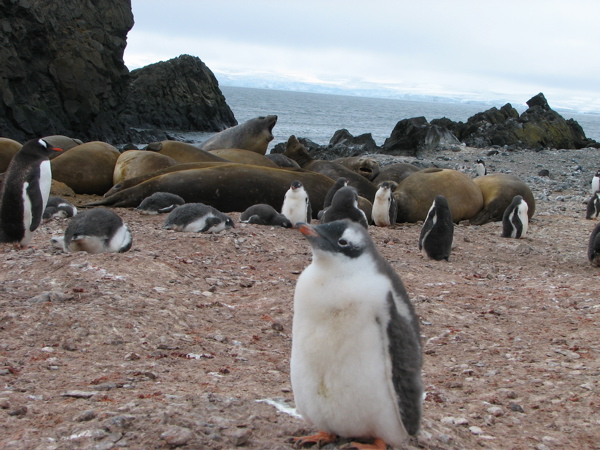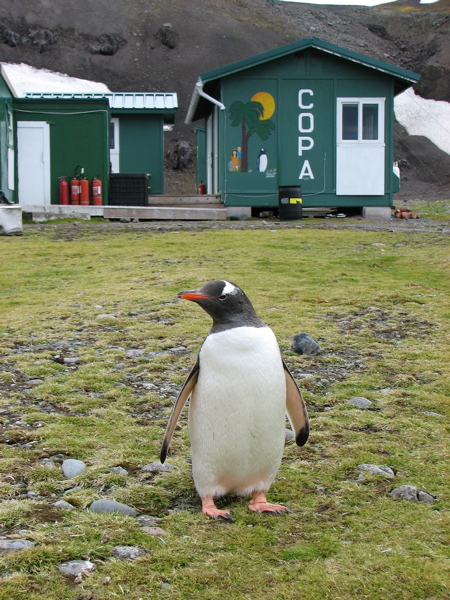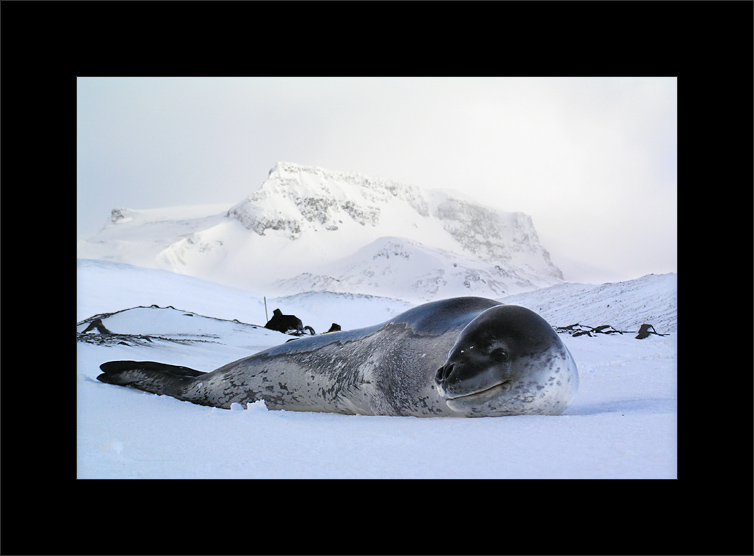

by Kristen Green, Ichthyology Lab
February 4, 2008: It’s February, and it’s starting to feel like the season is coming to a close. The Gentoo chicks have been on the deck most nights…..looking guilty as usual when I open the door at 3 AM. They used to scatter, face-planting off the deck in a rush. Now, the bolder chicks nonchalantly waddle away from me; cleanly executing the foot drop-off from the deck. Those chicks have spent substantial time on the deck and it shows. Ten minutes later, the pitter-patter of little penguin feet and tap-tap of beaks betrays the curious chicks again. We’ve built elaborate barricades to keep them off the deck using two-by-fours, ice chests, and old propane tanks, but the stealthiest chicks still find new loopholes. I think our barricades are just training them to jump higher. I came out the other day to find a chick sleeping on top of an ice chest we used to block off an access point.

The chicks on the deck are entertaining, but they are also a sign that the penguin work here is almost over. We held the ‘Chick Round up’ last week, a muddy affair where we herd dozens of squawking chicks at a time into a small seining net, like the kind you would drag through the surf to catch fish. We then place metal bands on their flippers. 250 Adelie and 250 Gentoo chicks are banded this way each season. The Adelie fledglings have already begun their migration to find southern pack ice, and won’t return to King George Island to breed until they are three year olds. Castle Rocks, the largest Adélie colony, was filled with thousands of birds the day I arrived. Suddenly, the colony is deserted, and only the distinctive smell of penguin guano lingers. The metal bands on the “known-age” chicks (called as such since we know the exact season they were hatched) are numbered and wrapped with a strip of red electrical tape, which will help to identify the incoming Adélie three-year olds in the 2011-2012 season. Meanwhile, the Gentoo fledgings will stay here, and follow their parents into the ocean and back for short foraging trips all winter.
In addition to the chick banding, this week is our last big push to wrap up all the penguin work. The Chinstrap penguins are the last penguin work we do, as they breed a few weeks later than the Adelie and Gentoo penguins. Last week we hiked all the gear to deploy satellite transmitters and take diet samples to Demay Point, four miles away, where the closest Chinstrap colonies are located. We had good weather, and were able to get the first stage of our work done at these Chinstrap colonies. However, we’ve been waiting all week for a good day to retrieve satellite transmitters and take the final diet samples from the Chinstrap colonies. The end of the penguin work isn’t the only sign that the season is drawing to a close. Most of December and January, it never really got dark at all, now the sun sets at 10:30 pm. The weather patterns are also changing; the frequency of low pressure systems have been increasing. The rapid falls in pressure are usually accompanied by snow storms from the southeast.
Yesterday we finally got our window between snowstorms. Unfortunately, we only had two people to do the work on one of the longest days we’ve had all season. Wayne, our boss, left a week earlier than planned since his original transportation out was canceled, and Amy hurt her ankle a few weeks ago and can’t hike. Only Dave and I were able to go to the Chinstrap penguin colonies. In these past four months, the field work has always felt challenging rather than tedious, but the laundry list of scientific tasks yesterday felt a little overwhelming; hike 4 miles over to other side of the island, canoe across the face of the glacier, record data at 50 skua territories, count seals, retrieve satellite transmitters, take diet samples, collect feathers, count chicks, and then backpack home with more weight than when we started: 8 pounds of regurgitated krill. It was definitely an exercise in One Thing At a Time. After a solid 10 hour day, we came home and sorted krill until midnight. An army of chicks wouldn’t have roused me from bed last night.

As a celebration, the annual Copa Formal was scheduled for today. It’s an invite only, black tie event. Remote field camps are no excuse for fine dining and elegant dress. However, as I write, the barometer is dropping, and a full snowstorm has hit. I can see snow slinging across the front yard, and big surf rolling out my window. There is a brief but unpleasant transition between the bunkhouse and main room though 40 knot winds and stinging sleet. I think we’ll have to reschedule for tomorrow so our international guests can make it.
The penguin chicks, however, are oblivious; they’ve taken advantage of the wind-collapsed barricade as a new ramp to parade up the deck and try to catch snow with their beaks.

